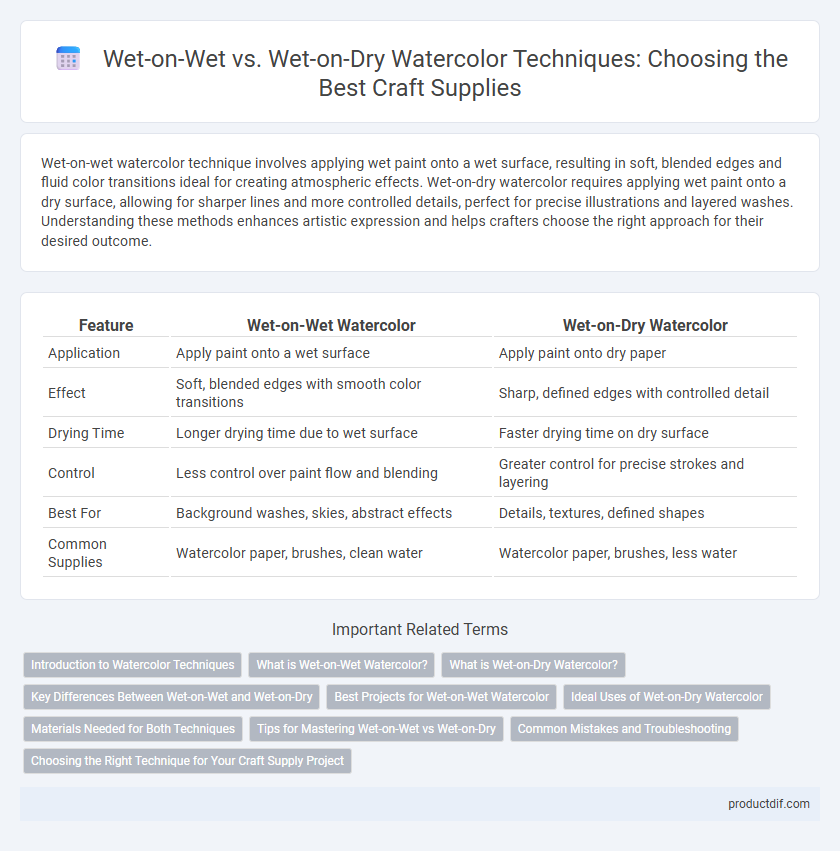Wet-on-wet watercolor technique involves applying wet paint onto a wet surface, resulting in soft, blended edges and fluid color transitions ideal for creating atmospheric effects. Wet-on-dry watercolor requires applying wet paint onto a dry surface, allowing for sharper lines and more controlled details, perfect for precise illustrations and layered washes. Understanding these methods enhances artistic expression and helps crafters choose the right approach for their desired outcome.
Table of Comparison
| Feature | Wet-on-Wet Watercolor | Wet-on-Dry Watercolor |
|---|---|---|
| Application | Apply paint onto a wet surface | Apply paint onto dry paper |
| Effect | Soft, blended edges with smooth color transitions | Sharp, defined edges with controlled detail |
| Drying Time | Longer drying time due to wet surface | Faster drying time on dry surface |
| Control | Less control over paint flow and blending | Greater control for precise strokes and layering |
| Best For | Background washes, skies, abstract effects | Details, textures, defined shapes |
| Common Supplies | Watercolor paper, brushes, clean water | Watercolor paper, brushes, less water |
Introduction to Watercolor Techniques
Wet-on-wet watercolor technique involves applying wet paint onto a wet surface, creating soft edges and fluid color blends ideal for backgrounds and atmospheric effects. Wet-on-dry watercolor requires applying wet paint onto a dry surface, allowing for sharper edges and more precise details suitable for defined shapes and textures. Understanding these fundamental techniques is essential for mastering control and expression in watercolor painting.
What is Wet-on-Wet Watercolor?
Wet-on-wet watercolor is a painting technique where wet paint is applied onto a wet surface, allowing colors to blend softly and create fluid transitions. This method enhances effects like gradients, soft edges, and atmospheric backgrounds, making it ideal for landscapes and abstract art. The water saturation controls color diffusion, producing unique textures that differ significantly from wet-on-dry watercolor methods.
What is Wet-on-Dry Watercolor?
Wet-on-dry watercolor involves applying wet paint onto a completely dry paper surface, allowing for precise edges and detailed layering. This technique provides artists with greater control over shapes and color intensity, making it ideal for creating defined textures and sharp contrasts. Compared to wet-on-wet, wet-on-dry watercolor offers increased accuracy and the ability to build up multiple translucent layers without colors blending unpredictably.
Key Differences Between Wet-on-Wet and Wet-on-Dry
Wet-on-wet watercolor technique involves applying wet paint onto a wet surface, resulting in soft edges and fluid color blending, ideal for creating smooth gradients and atmospheric effects. Wet-on-dry watercolor requires painting wet pigment onto dry paper, offering more control and defined edges, perfect for detailed work and sharper contrasts. Understanding these key differences helps artists choose the appropriate method to achieve desired textures and visual impact in craft projects.
Best Projects for Wet-on-Wet Watercolor
Wet-on-wet watercolor techniques excel in creating soft gradients, fluid blends, and atmospheric effects, making them ideal for landscapes, skies, and floral paintings where smooth transitions dominate. This method requires wet paper and wet paint application, promoting pigment diffusion and spontaneous texture formation. Artists often select wet-on-wet for expressive backgrounds, ethereal color washes, and abstract compositions where control is less rigid and color interaction is emphasized.
Ideal Uses of Wet-on-Dry Watercolor
Wet-on-dry watercolor techniques are ideal for creating precise lines, sharp edges, and detailed textures in artwork, making them perfect for botanical illustrations and architectural renderings. This method allows artists to layer colors without unwanted blending, enhancing control and color vibrancy in craft projects. Wet-on-dry watercolor is especially favored in mixed-media crafts where distinct color separation is crucial for the overall design.
Materials Needed for Both Techniques
Wet-on-wet watercolor requires highly absorbent paper such as cotton rag or 140 lb cold-pressed paper, along with soft brushes like round or mop brushes that retain water for smooth blending. Wet-on-dry watercolor techniques use similar quality paper but benefit from stiffer brushes like flat or detail brushes to apply precise, controlled strokes. Both methods demand high-quality, transparent pigments and a palette for mixing, while water containers and paper towels are essential for maintaining brush moisture and cleaning.
Tips for Mastering Wet-on-Wet vs Wet-on-Dry
Mastering wet-on-wet watercolor requires applying paint on a pre-wet paper surface to create soft, blended effects and seamless color transitions, ideal for backgrounds and atmospheric scenes. Wet-on-dry techniques involve layering paint on dry paper, allowing for sharper edges, finer details, and controlled textures, perfect for intricate illustrations. Using high-quality cold-pressed watercolor paper and balancing brush moisture are essential tips to optimize the unique qualities of each method in craft projects.
Common Mistakes and Troubleshooting
Common mistakes in wet-on-wet watercolor include applying too much water, causing colors to bleed uncontrollably, and not prepping paper adequately, leading to uneven pigment dispersion. In wet-on-dry techniques, overworking areas can create streaks and harsh edges instead of smooth gradients. Troubleshooting involves controlling water-to-pigment ratio and practicing layering to achieve desired blending without losing detail or creating unintended blooms.
Choosing the Right Technique for Your Craft Supply Project
Wet-on-wet watercolor technique allows pigments to blend seamlessly on damp paper, creating soft edges and fluid color transitions ideal for backgrounds and abstract designs. Wet-on-dry watercolor delivers sharper lines and more controlled details by applying pigment on dry paper, perfect for intricate patterns and defined shapes in craft supply projects. Selecting the right method depends on the desired texture, control, and effect in your artwork to enhance the visual impact of your craft supplies.
Wet-on-wet watercolor vs Wet-on-dry watercolor Infographic

 productdif.com
productdif.com